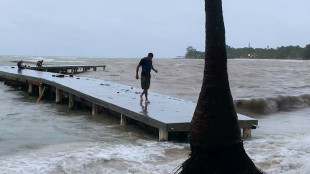
-
 'Megaquake' warning hits Japan's growth
'Megaquake' warning hits Japan's growth
-
Stiff business: Berlin startup will freeze your corpse for monthly fee

-
 Wars, looming Trump reign set to dominate G20 summit
Wars, looming Trump reign set to dominate G20 summit
-
Xi, Biden attend Asia-Pacific summit, prepare to meet

-
 Kyrgios to make competitive return at Brisbane next month after injuries
Kyrgios to make competitive return at Brisbane next month after injuries
-
Dominican Juan Luis Guerra triumphs at 25th annual Latin Grammys

-
 Landslide win for Sri Lanka president's leftist coalition in snap polls
Landslide win for Sri Lanka president's leftist coalition in snap polls
-
Australian World Cup penalty hero Vine takes mental health break

-
 As Philippines picks up from Usagi, a fresh storm bears down
As Philippines picks up from Usagi, a fresh storm bears down
-
Tropical Storm Sara pounds Honduras with heavy rain

-
 Pepi gives Pochettino win for USA in Jamaica
Pepi gives Pochettino win for USA in Jamaica
-
'Hell to heaven' as China reignite World Cup hopes with late winner

-
 Rebel attacks keep Indian-run Kashmir on the boil
Rebel attacks keep Indian-run Kashmir on the boil
-
New Zealand challenge 'immense but fantastic' for France

-
 Under pressure England boss Borthwick in Springboks' spotlight
Under pressure England boss Borthwick in Springboks' spotlight
-
All Blacks plan to nullify 'freakish' Dupont, says Lienert-Brown

-
 TikTok makes AI driven ad tool available globally
TikTok makes AI driven ad tool available globally
-
Japan growth slows as new PM readies stimulus

-
 China retail sales pick up speed, beat forecasts in October
China retail sales pick up speed, beat forecasts in October
-
Asian markets fluctuate at end of tough week

-
 Gay, trans people voicing -- and sometimes screaming -- Trump concerns
Gay, trans people voicing -- and sometimes screaming -- Trump concerns
-
Argentina fall in Paraguay, Brazil held in Venezuela

-
 N. Korean leader orders 'mass production' of attack drones
N. Korean leader orders 'mass production' of attack drones
-
Pakistan's policies hazy as it fights smog

-
 Nature pays price for war in Israel's north
Nature pays price for war in Israel's north
-
New Zealand's prolific Williamson back for England Test series

-
 Mexico City youth grapple with growing housing crisis
Mexico City youth grapple with growing housing crisis
-
After Trump's victory, US election falsehoods shift left

-
 Cracks deepen in Canada's pro-immigration 'consensus'
Cracks deepen in Canada's pro-immigration 'consensus'
-
Xi inaugurates South America's first Chinese-funded port in Peru

-
 Tyson slaps Paul in final face-off before Netflix bout
Tyson slaps Paul in final face-off before Netflix bout
-
England wrap-up T20 series win over West Indies

-
 Stewards intervene to stop Israel, France football fans clash at Paris match
Stewards intervene to stop Israel, France football fans clash at Paris match
-
Special counsel hits pause on Trump documents case

-
 Japan's Princess Mikasa, great aunt to emperor, dies aged 101
Japan's Princess Mikasa, great aunt to emperor, dies aged 101
-
Cricket at 2028 Olympics could be held outside Los Angeles

-
 Trump names vaccine skeptic RFK Jr. to head health dept
Trump names vaccine skeptic RFK Jr. to head health dept
-
Ye claims 'Jews' controlling Kardashian clan: lawsuit

-
 Japan into BJK Cup quarter-finals as Slovakia stun USA
Japan into BJK Cup quarter-finals as Slovakia stun USA
-
Sri Lanka president's party headed for landslide: early results

-
 Olympics 'above politics' say LA 2028 organisers after Trump win
Olympics 'above politics' say LA 2028 organisers after Trump win
-
Panic strikes Port-au-Prince as residents flee gang violence

-
 Carsley hails England's strength in depth as understudies sink Greece
Carsley hails England's strength in depth as understudies sink Greece
-
Undefeated Chiefs lose kicker Butker to knee injury

-
 Wallabies winger Vunivalu signs for La Rochelle
Wallabies winger Vunivalu signs for La Rochelle
-
Musk met Iran UN ambassador on defusing tension under Trump: NYT

-
 Vinicius misses penalty as Brazil held in Venezuela
Vinicius misses penalty as Brazil held in Venezuela
-
World's tallest teen Rioux won't make college debut until 2025

-
 Ace helps Jeon grab share of LPGA Annika lead with Hull
Ace helps Jeon grab share of LPGA Annika lead with Hull
-
Italy and security-tight France lock up Nations League quarter-final spots

| RBGPF | 100% | 61.84 | $ | |
| JRI | -0.23% | 13.21 | $ | |
| SCS | -0.75% | 13.27 | $ | |
| BCC | -1.57% | 140.35 | $ | |
| NGG | 0.4% | 62.37 | $ | |
| RIO | -0.31% | 60.43 | $ | |
| BCE | -1.38% | 26.84 | $ | |
| GSK | -2.09% | 34.39 | $ | |
| CMSC | -0.24% | 24.55 | $ | |
| RELX | -0.37% | 45.95 | $ | |
| CMSD | -0.02% | 24.725 | $ | |
| RYCEF | -4.71% | 6.79 | $ | |
| BTI | 0.2% | 35.49 | $ | |
| VOD | -0.81% | 8.68 | $ | |
| AZN | -0.38% | 65.04 | $ | |
| BP | 1.65% | 29.05 | $ |

New York drought conditions fan flames, spur water saving
New York has urged its 8.5 million residents to save water as America's biggest city endures an unprecedented period without significant rainfall, creating potentially dangerous drought conditions and fanning the flames of deadly wildfires.
Since Friday, wildfires have burned through thousands of acres on the border between New York and New Jersey, just an hour from Manhattan, claiming the life of an 18-year-old firefighter battling the blazes.
On the New York side, officials said the fire was the largest on record since 2008, fueled by dry winds.
New York and other parts of the state north of the city are under a red flag warning for bush and forest fires with high winds, low humidity and dry conditions creating tinderbox conditions.
There was even a small fire over the weekend in New York's Prospect Park, a large green space in the city's densely populated Brooklyn borough, although it was quickly extinguished.
"The reality is, the drought that we're currently experiencing is just one example of how a changing climate is impacting our state today, not far off into the future, but right now," said New Jersey Governor Phil Murphy.
New York City and the surrounding region have gone without significant rainfall for much of September and October, and November has been mostly dry so far.
- Perfect storm -
The drought-like conditions have coincided with a major overhaul of New York's water supply system, which has seen the city source more from a reservoir in Catskill Park, located in an area particularly affected by the dry conditions.
"While there is plenty of water in our reservoirs now, we are working to start public conservation efforts now in case this drought continues," the city's department of environmental protection said in a statement.
The city's fire department has called on residents to flag leaking fire hydrants so they can be closed, warning in an Instagram post that "an open hydrant can release more than 1,000 gallons per minute."
New York City's average daily water demand has decreased by approximately 35 percent in recent decades, but officials say more can be done to avoid waste, calling on residents to only flush toilets when necessary and to take shorter showers.
The reservoirs relied on by the city, which are usually filled by rainfall in October and November, are only 62 percent full -- far less than the normal level of about 79.2 percent.
The Office of Natural Lands Management said that the ground in parts of New Jersey was dry almost eight inches down -- the worst situation in more than 100 years -- meaning it would require that many inches of rainfall to bring the soil back to saturation.
There is no rainfall forecast in the area this week, and parts of New York have imposed a drought watch -- two steps below a drought emergency at which point homes and businesses are forced to restrict water use.
Drought-hit areas of New Jersey are already one notch above New York's, at the drought warning stage.
"The impact of this on wildfires cannot be overstated," said Greg McLaughlin, chief of the New Jersey Forest Fire Service, which has responded to 537 wildfires so far this year -- 500 more than in the same period last year.
Brian Fuchs, a climatologist at the University of Nebraska-Lincoln, said it had been over 20 years since a similar drought episode in the northeastern United States.
"One of the attributes that is starting to come out (with climate change) is these rapid transitions from either very wet periods to very dry periods, or very dry periods to very wet periods," he said.
R.Lee--AT

